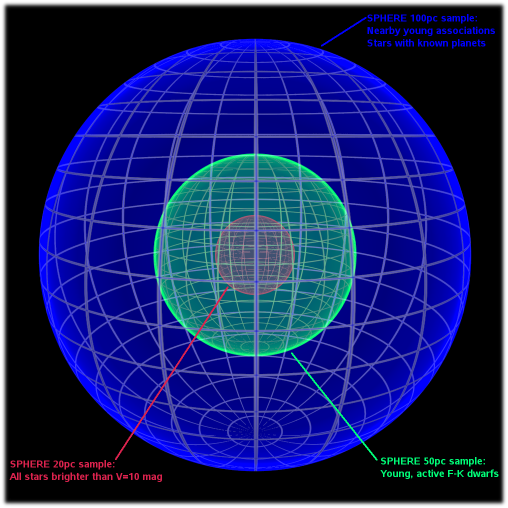 Spectro-Polarimetric High-contrast Exo-planet REsearch
Spectro-Polarimetric High-contrast Exo-planet REsearch
Science
Science with SPHERE
The primary goal of extra-solar planet science of the next decade will be a better understanding of the mechanisms of formation and evolution of planetary systems. The fundamental observational parameter is the frequency of planets as a function of mass and separation.
models of planet formation predict that the peak of formation of giant planets is found close to the snowline. In outer regions, planet formation is a less efficient process. However, migration mechanisms and long term orbit instabilities will alter the original distribution. Determination of the frequency of giant planets in wide orbits (> 5-10 AU) will allow to test basic aspects of the planet formation models. Beside frequency, it would also be interesting to derive the distributions of planets parameters such as mass, semi-major axis and eccentricities.
The main scientific goal of SPHERE will be then the description of the properties of young planets in the expected peak region of gas giant formation and in the outer regions of the systems. Imaging of planets already detected by radial velocity and/or astrometry would additionally represent a major breakthrough thanks to the availability of dynamical constraints (or even full orbit determinations) on the planet masses and on the orbital elements. Therefore, these objects will represent the ideal benchmarks for the calibration of models for sub-stellar objects.
- Nearby young associations (10-100 Myr, 30-100pc) will offer the best chance of detecting low mass planets, since they will have brighter sub-stellar companions.
- Young active F-K dwarfs of the Solar neighbourhood (ages less than 1 Gyr, d < 50pc).
- The nearest stars (all ages within 20pc of the Sun) will allow probe the smallest orbits and will also be the only opportunities for detecting planets by directly reflected light.
- Stars with known planets, especially any that exhibit long-term residuals in their radial velocity curves, indicating the possible presence of a more distant planet (F-G-K stars within 50-100pc).
- Young early type stars.
- Planet candidates from astrometric surveys.

Other types of targets include a set of planets shining by reflecting stellar light might be detected by the SPHERE polarimetric channel (ZIMPOL). Also, related areas of study such as brown dwarfs, star and planet formation (e.g. via imaging of disks), Solar System objects (asteroids), etc. will provide a large sample of targets. These domains will nicely enrich the scientific impact of the instrument. Their instrumental needs should however not be in conflict with the high-contrast requirements.


